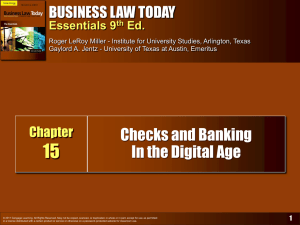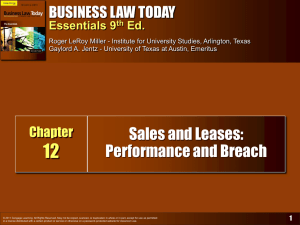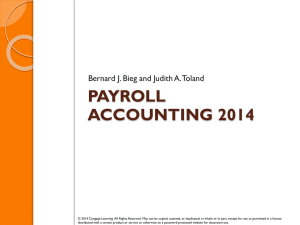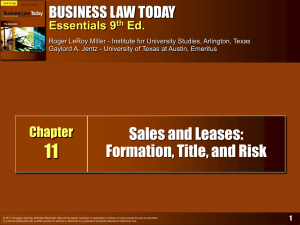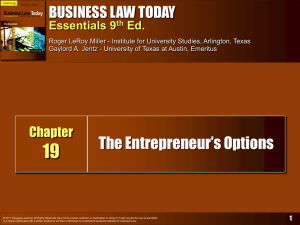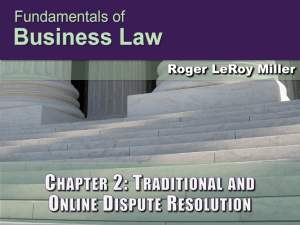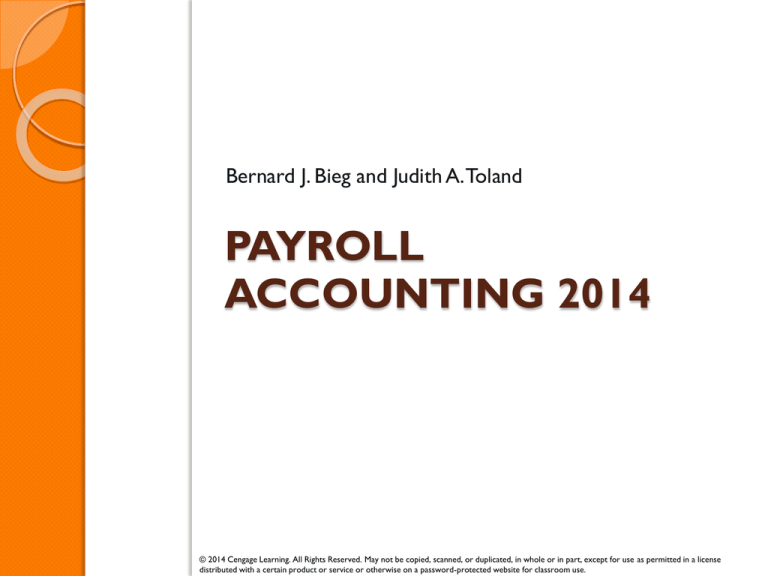
Bernard J. Bieg and Judith A. Toland
PAYROLL
ACCOUNTING 2014
© 2014 Cengage Learning. All Rights Reserved. May not be copied, scanned, or duplicated, in whole or in part, except for use as permitted in a license
distributed with a certain product or service or otherwise on a password-protected website for classroom use.
SOCIAL SECURITY TAXES
Chapter 3
© 2014 Cengage Learning. All Rights Reserved. May not be copied, scanned, or duplicated, in whole or in part, except for use as permitted in a license distributed with a certain product or
service or otherwise on a password-protected website for classroom use.
Learning Objectives
1.
2.
3.
4.
5.
Identify which persons are covered
under social security law
Identify types of compensation that are
defined as wages
Apply current tax rates and wage base
for FICA/SECA purposes
Describe different
requirements/procedures for depositing
FICA/FIT taxes
Complete Form 941
© 2014 Cengage Learning. All Rights Reserved. May not be copied, scanned, or duplicated, in whole or in part, except for use as permitted in a license distributed with a certain product or
service or otherwise on a password-protected website for classroom use.
Coverage under FICA
FICA (1935)
◦
◦
◦
◦
Federal Insurance Contributions Act
Tax paid both by employees and employers
6.2% employer OASDI plus 1.45% HI
6.2% employee OASDI plus 1.45% HI
LO-1
© 2014 Cengage Learning. All Rights Reserved. May not be copied, scanned, or duplicated, in whole or in part, except for use as permitted in a license distributed with a certain product or
service or otherwise on a password-protected website for classroom use.
Coverage under FICA (cont.)
SECA (1951)
◦ Self-Employment Contributions Act
◦ Tax upon net earnings of self-employed
◦ (6.2% + 6.2%) = 12.4% OASDI plus (1.45% +
1.45%) = 2.9% HI
LO-1
© 2014 Cengage Learning. All Rights Reserved. May not be copied, scanned, or duplicated, in whole or in part, except for use as permitted in a license distributed with a certain product or
service or otherwise on a password-protected website for classroom use.
Coverage under FICA (cont.)
3 issues
◦ Are you an employee or an independent
contractor?
◦ Is service rendered considered employment?
◦ Is compensation considered taxable wages?
◦ http://www.socialsecurity.gov/employer
LO-1
© 2014 Cengage Learning. All Rights Reserved. May not be copied, scanned, or duplicated, in whole or in part, except for use as permitted in a license distributed with a certain product or
service or otherwise on a password-protected website for classroom use.
Independent Contractor (SECA)
vs. Employee (FICA)
◦ Every person is an employer if “person
employs one or more individuals for
performance of services in U.S.”
“Person includes trusts, estates, individual,
partnership or corporation”
LO-1
© 2014 Cengage Learning. All Rights Reserved. May not be copied, scanned, or duplicated, in whole or in part, except for use as permitted in a license distributed with a certain product or
service or otherwise on a password-protected website for classroom use.
Independent Contractor (SECA)
vs. Employee (FICA) (cont.)
◦ Certain occupations specifically covered by
FICA
Full-time life insurance salespersons
Agent- and commission-drivers of food/beverages
or dry cleaning
Full-time traveling salespersons
Individual working at home on products that
employer supplies and are returned to furnished
specifications
LO-1
© 2014 Cengage Learning. All Rights Reserved. May not be copied, scanned, or duplicated, in whole or in part, except for use as permitted in a license distributed with a certain product or
service or otherwise on a password-protected website for classroom use.
Independent Contractor (SECA)
vs. Employee (FICA) (cont.)
◦ If employer misclassifies employees, there is a
penalty
Generally equal to employer’s share of FICA plus
income taxes/FICA that were not withheld from
employees’ earnings
However, if employee reported earnings on 1040,
penalty is voided
Penalty may be reduced if employer filed a 1099
LO-1
© 2014 Cengage Learning. All Rights Reserved. May not be copied, scanned, or duplicated, in whole or in part, except for use as permitted in a license distributed with a certain product or
service or otherwise on a password-protected website for classroom use.
FICA Taxable Wage Base
OASDI wages cap (actual) at $113,700 for
2013
OASDI wages cap (estimated) at
$117,900 for 2014
HI wages never cap – since there is not
ceiling, employers compute HI tax on full
amount of wages
LO-3
© 2014 Cengage Learning. All Rights Reserved. May not be copied, scanned, or duplicated, in whole or in part, except for use as permitted in a license distributed with a certain product or
service or otherwise on a password-protected website for classroom use.
FICA Taxable Wage Base (cont.)
"In addition to the above taxes the 2010
Affordable Care Act imposes the
following taxes:“
◦ An additional 0.9% HI surtax on taxpayers
receiving wages in excess of $200,000
($250,000 if married filing jointly)
◦ A surtax of 3.8% on modified AGI in excess of
$200,000 ($250,000 if married filing join)
◦ Employer does not match either of these
surtaxes
LO-3
© 2014 Cengage Learning. All Rights Reserved. May not be copied, scanned, or duplicated, in whole or in part, except for use as permitted in a license distributed with a certain product or
service or otherwise on a password-protected website for classroom use.
FICA Taxable Wage Base (cont.)
Interesting note: In 1950 there were 16
workers paying into Social Security for
every one person collecting benefits.
By 2042, that ratio is projected to be 2 to
1.
LO-3
© 2014 Cengage Learning. All Rights Reserved. May not be copied, scanned, or duplicated, in whole or in part, except for use as permitted in a license distributed with a certain product or
service or otherwise on a password-protected website for classroom use.
Calculating FICA
Facts: Tamara earns $138,000/year and is
paid semimonthly on the15th and 30th;
determine FICA for October 30th payroll
◦ First must find prior payroll year-to-date gross
$138,000/24 =$ 5,750.00
◦ Hint: how many payrolls were run before the
10/30 payroll? Multiply that by the gross per
payroll:
$5,750.00 x 19 payrolls (before today)=
$109,250.00
LO-3
© 2014 Cengage Learning. All Rights Reserved. May not be copied, scanned, or duplicated, in whole or in part, except for use as permitted in a license distributed with a certain product or
service or otherwise on a password-protected website for classroom use.
Calculating FICA (cont.)
◦ How much will be taxed for OASDI?
$113,700– $109,250.00 = $4,450
Tamara’s OASDI tax is $4,450 x 6.2% = $275.90
Employer’s OASDI tax is $4,450 x 6.2% = $275.90
Both Tamara’s and the employer’s HI tax is
$5,750.00 x 1.45% =$ 83.38
◦ How much is total FICA?
Total FICA for Tamara is $275.90 + $83.38 =
$359.28
Total FICA for employer is $275.90 + $83.38
=$359.28
LO-3
© 2014 Cengage Learning. All Rights Reserved. May not be copied, scanned, or duplicated, in whole or in part, except for use as permitted in a license distributed with a certain product or
service or otherwise on a password-protected website for classroom use.
SECA and Independent
Contractors
Employee and employer portion of FICA
is paid if net earnings exceed $400
◦ Net Earnings = Net income + distributive
share of partnership income
If you own more than one business offset losses and income and calculate
FICA based on combined net income
In 2013 projected self-employed taxes =
15.3% (6.2% + 1.45% and 6.2% + 1.45%)
LO-3
© 2014 Cengage Learning. All Rights Reserved. May not be copied, scanned, or duplicated, in whole or in part, except for use as permitted in a license distributed with a certain product or
service or otherwise on a password-protected website for classroom use.
SECA and Independent
Contractors (cont.)
Can have W-2 and self employment
income
◦ Count both towards calculating cap of
$113,700 for OASDI
Report on Schedule C (Form 1040)
“Profit or Loss from Business”
Also file Schedule SE (Form 1040) “SelfEmployment Tax”
◦ Must include SECA taxes in quarterly
estimated payments
LO-3
© 2014 Cengage Learning. All Rights Reserved. May not be copied, scanned, or duplicated, in whole or in part, except for use as permitted in a license distributed with a certain product or
service or otherwise on a password-protected website for classroom use.
Calculating FICA with W-2 and
Self-Employed Earnings
◦ Facts: Celia’s W-2 = $117,768 and her selfemployment income = $14,500; how much is
her FICA on $14,500?
No OASDI is due because Celia capped on W-2
HI = $14,500 x 2.9% = $420.50
Total FICA is therefore = $420.50
LO-3
© 2014 Cengage Learning. All Rights Reserved. May not be copied, scanned, or duplicated, in whole or in part, except for use as permitted in a license distributed with a certain product or
service or otherwise on a password-protected website for classroom use.
Depositing FIT & FICA
FICA & FIT always deposited together
Each November, IRS notifies ER whether
they will be a monthly or semiweekly
depositor for next calendar year
(“lookback period”)
◦ Monthly - pay FICA and FIT by 15th of
following month
◦ Semiweekly – if payday is W, Th or F then due
following W and if payday is S, S, M or T then
due following F
LO-4
© 2014 Cengage Learning. All Rights Reserved. May not be copied, scanned, or duplicated, in whole or in part, except for use as permitted in a license distributed with a certain product or
service or otherwise on a password-protected website for classroom use.
Depositing FIT & FICA (cont.)
◦ However, there is an exception: One-day rule
states that if $100,000 or more of federal
payroll tax liability is due, taxpayer has until
close of next banking day
◦ New employers are monthly depositors
unless $100,000+ of liability triggers one-day
rule and converts them to semiweekly
◦ Different requirements for agricultural and
household employees
LO-4
© 2014 Cengage Learning. All Rights Reserved. May not be copied, scanned, or duplicated, in whole or in part, except for use as permitted in a license distributed with a certain product or
service or otherwise on a password-protected website for classroom use.
How to Deposit FIT
and FICA Electronically
Old paper-based system has been
replaced by an electronic depositing
system
Most employers are now on EFTPS
(Electronic Federal Tax Payment System) only exception is for businesses owing
$2,500 or loss in quarterly tax liabilities
◦ Enroll in EFTPS Online at
http://www.eftps.gov
LO-4
© 2014 Cengage Learning. All Rights Reserved. May not be copied, scanned, or duplicated, in whole or in part, except for use as permitted in a license distributed with a certain product or
service or otherwise on a password-protected website for classroom use.
How to Deposit FIT
and FICA Electronically (cont.)
◦ All new employers automatically pre-enrolled
◦ Two methods:
EFTPS (direct) – withdraw funds from employer’s
bank account and route to Treasury
EFTPS (through financial institution) – employer
instructs his/her bank to send payment directly to
Treasury
LO-4
© 2014 Cengage Learning. All Rights Reserved. May not be copied, scanned, or duplicated, in whole or in part, except for use as permitted in a license distributed with a certain product or
service or otherwise on a password-protected website for classroom use.
How to Report and Reconcile
FIT/FICA
File Form 941 (Employer’s Quarterly
Federal Tax Return)
◦ Download at www.irs.gov/formspubs/ or call
1-800-829-3676
Due on last day of month following close
of quarter
◦ January 31, April 30, July 30, October 31
◦ If that falls on weekend or legal holiday, file
next business day
LO-5
© 2014 Cengage Learning. All Rights Reserved. May not be copied, scanned, or duplicated, in whole or in part, except for use as permitted in a license distributed with a certain product or
service or otherwise on a password-protected website for classroom use.
How to Report and Reconcile
FIT/FICA (cont.)
Make deposit with Form 941 if taxes for
quarter are less than $2,500
◦ Use 941-V when making payment or can pay by
credit card
Electronic filing options available for
employers who meet requirements
◦ Complete an e-file application and then
electronically submit 941 or apply for a PIN on
IRS website and file electronically through thirdparty transmitter
◦ Can correct errors on previously filed Form 941
by filing Form 941-X
LO-5
© 2014 Cengage Learning. All Rights Reserved. May not be copied, scanned, or duplicated, in whole or in part, except for use as permitted in a license distributed with a certain product or
service or otherwise on a password-protected website for classroom use.
Types of Penalties
Failure-to-comply penalties will be added
to tax and interest charges; negligence can
also result in fines/imprisonment
◦ Interest set quarterly, based on short-term
Treasury bill rate
LO-5
© 2014 Cengage Learning. All Rights Reserved. May not be copied, scanned, or duplicated, in whole or in part, except for use as permitted in a license distributed with a certain product or
service or otherwise on a password-protected website for classroom use.
Types of Penalties (cont.)
Penalties imposed for following:
◦
◦
◦
◦
Not filing employment tax returns on time
Not paying full taxes when due
Not making timely deposits
Not furnishing W-2s to employees on timely
basis
◦ Not filing information returns with IRS on
time
◦ Not supplying identification numbers
LO-5
◦ Writing bad checks
© 2014 Cengage Learning. All Rights Reserved. May not be copied, scanned, or duplicated, in whole or in part, except for use as permitted in a license distributed with a certain product or
service or otherwise on a password-protected website for classroom use.
Types of Penalties (cont.)
Note: IRS reports that 100,000 businesses owe
more than two years of payroll taxes (estimated
at $58 billion)!!
LO-5
© 2014 Cengage Learning. All Rights Reserved. May not be copied, scanned, or duplicated, in whole or in part, except for use as permitted in a license distributed with a certain product or
service or otherwise on a password-protected website for classroom use.


